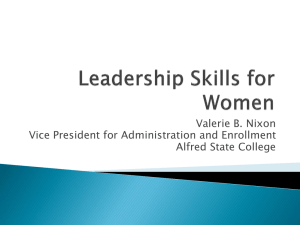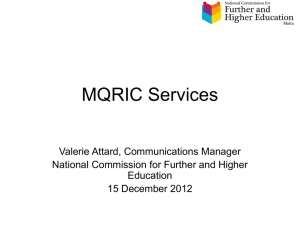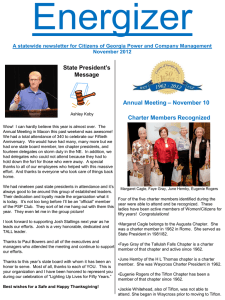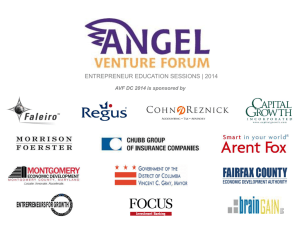click here to presentation slides.
advertisement
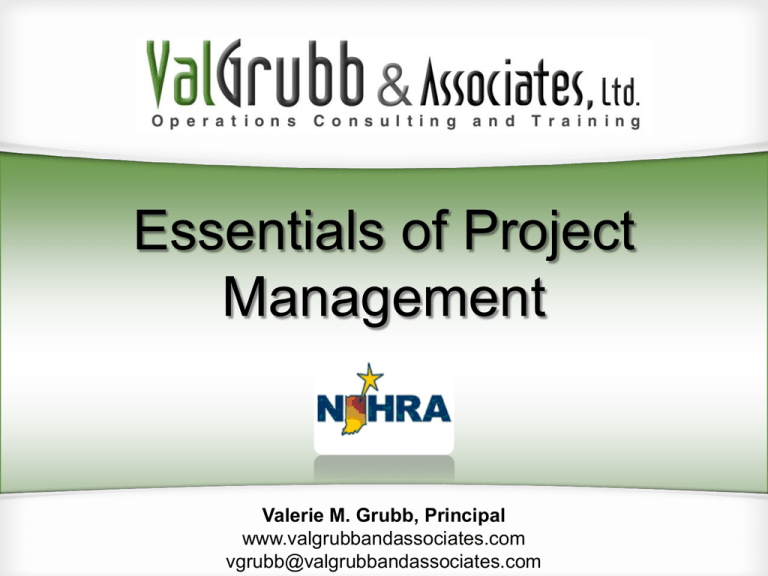
Essentials of Project Management Valerie M. Grubb, Principle Valerie M. Grubb, Principal www.valgrubbandassociates.com www.valgrubbandassociates.com vgrubb@valgrubbandassociates.com Why PM Skills are Important Individual Contribution Roll-out HRIS software Outsourcing HR activities Developing new employee programs Conducting legal compliance audit Starting an HR department Strategic Contribution M&A Downsizing or restructuring Realign performance appraisals to match strategic goals Developing crisis mgmt plan Facilitating culture change Valerie M. Grubb, Principal www.valgrubbandassociates.com vgrubb@valgrubbandassociates.com Where to Start “Plan your work and then work your plan.” Norman Vincent Peale author, The Power of Positive Thinking Valerie M. Grubb, Principal www.valgrubbandassociates.com vgrubb@valgrubbandassociates.com Pre-Project Planning 1. Defining the Project Scope 2. Your Project Plan 3. Adding Costs to the Equation 4. Risks 5. Roles & Responsibilities Valerie M. Grubb, Principal www.valgrubbandassociates.com vgrubb@valgrubbandassociates.com Project Scope Why is formalizing what is IN and what is OUT so important? Valerie M. Grubb, Principal www.valgrubbandassociates.com vgrubb@valgrubbandassociates.com What’s IN and What’s OUT Defining Project Scope Draws a “line in the sand” of exactly what will be included and what will not Helps to establish very clear expectations for your customer(s) Good reference in the event there are questions as the project progresses Acts as your foundation as new tasks are added (and the timeline adjusts) Valerie M. Grubb, Principal www.valgrubbandassociates.com vgrubb@valgrubbandassociates.com Goal Breakdown Structure Project Goal Objectives (Critical Success Factors) Subject Matter Experts Senior Management Functional Managers Deliverables (Critical Success Measures) Requirements (definitions on form, fit, feature, function) From Improving your Project Management Skills by Larry Richman, AMACOM, 2006. Valerie M. Grubb, Principal www.valgrubbandassociates.com vgrubb@valgrubbandassociates.com SMART Project Objectives S pecific Is the objective clear about what, where, when, and how? M easurable Is there a reliable system in place to evaluate? Does it have a clear measurement of success? ccurate & Agreed to Is it stated accurately to ensure you can measure the results correctly? Have you gained consensus and agreement from key stakeholders? elevant Does this objective map to a company result? Can the project team make an impact on the situation? ime- Bound Is there a finish and/or a start date clearly stated or defined? A R T Valerie M. Grubb, Principal www.valgrubbandassociates.com vgrubb@valgrubbandassociates.com Refining the Objectives Project Deliverables: Measurable results, outcomes or specific products or services that must be provided in order to consider the project complete Deliverables, like goals, should be specific and measurable The more specific the deliverables, the easier it will be to plan and estimate project activities Each of these deliverables requires some type of action and most large, complex projects have phased deliverables Valerie M. Grubb, Principal www.valgrubbandassociates.com vgrubb@valgrubbandassociates.com Refining the Deliverables Project Requirements: Different from goals and deliverables – they help define how we know the goal or deliverable is completed successfully Requirements are a further breakdown of the deliverables; they describe the characteristics of the deliverable in very specific detail Example: our deliverable is a BEER, but the requirements are that it be AMBER, IN A BOTTLE, etc. Valerie M. Grubb, Principal www.valgrubbandassociates.com vgrubb@valgrubbandassociates.com Breaking Down the Goal-Example Goal Breakdown Structure (GBS) Levels Project Goal Double market share of Product XYZ by end of 2013. Objectives 1. Market Size (Critical Success Factors Deliverables (Critical Success Measures) 1.1 From $25k/yr to $40K/yr Requirements 1.1.1 Maintain 20% profit margin Valerie M. Grubb, Principal www.valgrubbandassociates.com vgrubb@valgrubbandassociates.com Breaking Down the Goal-Example Goal Breakdown Structure (GBS) Levels Goal Objectives (Critical Success Factors Deliverables (Critical Success Measures) Requirements Project Double market share of Product XYZ by end of 2013. 1. Market Size 2. Market Share 3. Product quality 4. Rework 5. Satisfaction rates 1.1 From $25k/yr to $40K/yr 1.1.1 Maintain 20% profit margin Valerie M. Grubb, Principal www.valgrubbandassociates.com vgrubb@valgrubbandassociates.com Breaking Down the Goal-Example Goal Breakdown Structure (GBS) Levels Goal Objectives (Critical Success Factors Deliverables (Critical Success Measures) Requirements Project Double market share of Product XYZ by end of 2013. 1. Market Size 2. Market Share 3. Product quality 4. Rework 5. Satisfaction rates 1.1 From $25k/yr to $40K/yr 1.2 Capture 7.5% of new market 1.3 Achieve ISO quality certification 1.4 Decrease rework by 20% 1.5 Achieve customer satisfaction rating of "best-in" by Consumer Reports standards 1.1.1 Maintain 20% profit margin Valerie M. Grubb, Principal www.valgrubbandassociates.com vgrubb@valgrubbandassociates.com What’s IN and What’s OUT Why is formalizing what is IN and what is OUT so important? Why is gaining agreement from your boss on what is IN and what is OUT critical? Valerie M. Grubb, Principal www.valgrubbandassociates.com vgrubb@valgrubbandassociates.com What’s IN and What’s OUT GOAL: Reduce Inventory Costs WITHIN Project Scope NOT WITHIN Project Scope Comments Determine the cost savings of reducing the total number of parts by 25%. Reducing total number of parts will reduce our storage and tracking costs and reduce complexity. We should know by how much. Benchmark current That would take too much time. inventory costs against Besides, we don't have to know what our key competitors. competitors are doing in order to achieve significant reductions. Develop a plan to design Great idea, but it should be a separate parts complexity our of project run by product development future products. people. Develop a plan for just-inThis will save us on floor space and time parts delivery. inventory-carrying costs. We should have done this years ago. From The Essential of Project Management by Harvard Business Press, 2006. Valerie M. Grubb, Principal www.valgrubbandassociates.com vgrubb@valgrubbandassociates.com Finalizing the Project Scope Written sign-off of Project Scope is CRITICAL before you begin!!! Valerie M. Grubb, Principal www.valgrubbandassociates.com vgrubb@valgrubbandassociates.com Finalizing the Project Scope Before sign-off, ensure you’ve answered the following: Can we afford the project? If the project succeeds, will it be worth the cost? Do we have the skills needed to succeed? Will the project finish in time to make a difference for our business? Valerie M. Grubb, Principal www.valgrubbandassociates.com vgrubb@valgrubbandassociates.com Finalizing the Project Scope Sign-off of Project Scope: Key Stakeholders Key Management Team Members Project Sponsor Who could come back after the fact and “balk” at the scope of the project? Valerie M. Grubb, Principal www.valgrubbandassociates.com vgrubb@valgrubbandassociates.com Pre-Project Planning 1. Defining the Project Scope 2. Your Project Plan 3. Adding Costs to the Equation 4. Risks 5. Roles & Responsibilities Valerie M. Grubb, Principal www.valgrubbandassociates.com vgrubb@valgrubbandassociates.com Your Project Plan Where do you start when trying to define your Project Plan? Valerie M. Grubb, Principal www.valgrubbandassociates.com vgrubb@valgrubbandassociates.com Where to Start? START with the END! Valerie M. Grubb, Principal www.valgrubbandassociates.com vgrubb@valgrubbandassociates.com Where to Start? Start with the end in mind to help you define where you need to go and what you need to do to get there. As-is state To-be state What major drivers exist that you should review? What tasks define how you’ll evaluate each major driver? Valerie M. Grubb, Principal www.valgrubbandassociates.com vgrubb@valgrubbandassociates.com When Beginning With the End… Think of the End Deliverable from your boss’s perspective: How would your boss define success? OR How will he or she indicate that the project has been completed satisfactorily? Valerie M. Grubb, Principal www.valgrubbandassociates.com vgrubb@valgrubbandassociates.com Begin with the End Anheuser Busch Project: • • • • $3.0 billion in revenue across Canada Upwards of $300MM residing in A/R In 2010, 30%+ of A/R were overdue ~2% of avg monthly receivables balance is written off as bad debt resulting in ~$2-3MM EBIDTA impact each year WHAT IS THE END DELIVERABLE? SUGGESTIONS ON HOW TO GET TO THE END DELIVERABLE? Valerie M. Grubb, Principal www.valgrubbandassociates.com vgrubb@valgrubbandassociates.com 24 Defining Your Project Plan Any questions on beginning with the end? Valerie M. Grubb, Principal www.valgrubbandassociates.com vgrubb@valgrubbandassociates.com Defining Your Project Plan Project Managers use a tool called a Work Breakdown Structure (WBS) to illustrate what tasks need to be accomplished. Valerie M. Grubb, Principal www.valgrubbandassociates.com vgrubb@valgrubbandassociates.com WBS Best Practices Start with major deliverables/milestones then work your way “down” (i.e., more detailed) based on each major task or deliverable. Involve the people who will have to do the work. You DON’T need to do it alone! Be sure to include any assumptions regarding the project. Consider presenting time factors as a range vs. a fixed # of days. Include a contingency BUT spell it out (don’t hide it within your estimate). Valerie M. Grubb, Principal www.valgrubbandassociates.com vgrubb@valgrubbandassociates.com Defining Your Project Plan A Work Breakdown Structure (WBS) is simply an outline of what needs to be done to accomplish your project. Simple WBS: Goal: Make land useable for construction 1. Conduct site survey 2. Obtain permits 3. Clear site 4. Excavate site 5. Regrade and groom site Valerie M. Grubb, Principal www.valgrubbandassociates.com vgrubb@valgrubbandassociates.com WBS Example HRIS Work Breakdown Structure Level 2 Subtasks 1.1.1 Survey other HR depts. for their best 1.1 Assess proposed practices 1 - Conduct needs system's interact with 1.1.2 Interview HR staffers to define process assessment current systems flows and functionality 2.1.1 Write separate specs for each module 2 - Create system 2.1 Specify database (benefits, recruitment, etc.) specifications functionality 2.2.2 Specify data-entry and retrieval processes 3.1.1 Design ad hoc report formats 3 - Design system 3.1 Design report formats 3.1.2 Design standard report formats 4.1.1. Engage technical security specialist 4.1 Ensure system's 4 - Develop system 4.1.2 Create security plan security 5.1 Develop user training 5.1.1 Develop online tutorial 5 - Install system 5.1.2 Create in person training program 6 - Evaluate 6.1 Assess effectiveness 6.1.1 Assess recruiting module 6.1.2 Assess applicant tracking modules system of modules Major Task Level 1 Subtask Valerie M. Grubb, Principal www.valgrubbandassociates.com vgrubb@valgrubbandassociates.com Defining Your Project Plan Once you identify the tasks that need to be accomplished, you then need to add the time it takes to accomplish each task. Valerie M. Grubb, Principal www.valgrubbandassociates.com vgrubb@valgrubbandassociates.com Defining Your Project Plan Gantt charts are a graphical representation of the duration of tasks Gantt charts illustrate how long a project should take Gantt charts also lay out the order in which tasks need to be carried out and any dependencies Valerie M. Grubb, Principal www.valgrubbandassociates.com vgrubb@valgrubbandassociates.com Estimating Time via WBS HRIS Work Breakdown Structure Major Task Level 1 Subtask 1.1 Assess proposed 1 - Conduct needs system's interact with assessment current systems 2 - Create system specifications 2.1 Specify database functionality 3 - Design system 3.1 Design report formats 4 - Develop system 5 - Install system 6 - Evaluate system 4.1 Ensure system's security Level 2 Subtasks 1.1.1 Survey other HR depts for their best practices 1.1.2 Interview HR staffers to define process flows and functionality 2.1.1 Write separate specs for each module (benefits, recruitment, etc.) 2.1.2 Specify data-entry and retrieval processes 3.1.1 Design ad hoc report formats 3.1.2 Design standard report formats 4.1.1 Engage technical security specialist 4.1.2 5.1 Develop user training 5.1.1 program 5.1.2 6.1 Assess effectiveness 6.1.1 of modules 6.1.2 Valerie M. Grubb, Principal www.valgrubbandassociates.com vgrubb@valgrubbandassociates.com Create security plan Develop online tutorial Create hands-on training Assess recruiting module Assess applicant tracking modules TOTAL DURATION (DAYS): Level 2 subtask duration (days) 2 2 4 3 3 2 5 4 10 5 3 3 46 Where to Start? @Home Exercise: • Using the End Goal worksheet, detail the major milestones and sub-tasks for your upcoming project. • How long will it take you to accomplish each individual task? What is the total length of your project? Valerie M. Grubb, Principal www.valgrubbandassociates.com vgrubb@valgrubbandassociates.com Defining Your Project Plan Has anyone done a Gantt chart before? Valerie M. Grubb, Principal www.valgrubbandassociates.com vgrubb@valgrubbandassociates.com Sample Gantt Chart Valerie M. Grubb, Principal www.valgrubbandassociates.com vgrubb@valgrubbandassociates.com Pre-Project Planning 1. Defining the Project Scope 2. Your Project Plan 3. Adding Costs to the Equation 4. Risks 5. Roles & Responsibilities Valerie M. Grubb, Principal www.valgrubbandassociates.com vgrubb@valgrubbandassociates.com Estimating Costs Conventional Project Management Wisdom says: You may want it good, fast and cheap BUT you only get TWO!! Valerie M. Grubb, Principal www.valgrubbandassociates.com vgrubb@valgrubbandassociates.com Estimating Costs Time, Cost & Performance Trade-offs: If technical requirements are fixed, compressing the schedule will probably increase project costs. The more the schedule is compressed, the greater the rate of increase in cost per unit of time. From Improving your Project Management Skills by Larry Richman, AMACOM, 2006. Valerie M. Grubb, Principal www.valgrubbandassociates.com vgrubb@valgrubbandassociates.com Estimating Costs Time, Cost & Performance Trade-offs: Adding requirements to the scope will either increase cost or time (or both!). If the budget is fixed, negotiation is necessary on the other two parameters. From Improving your Project Management Skills by Larry Richman, AMACOM, 2006. Valerie M. Grubb, Principal www.valgrubbandassociates.com vgrubb@valgrubbandassociates.com Estimating Costs Time vs. Cost Trade-off UNITS of COST Highest Cost Solution Early Finish Date Late Finish Date Least Cost Solution UNITS of TIME From Improving your Project Management Skills by Larry Richman, AMACOM, 2006. Valerie M. Grubb, Principal www.valgrubbandassociates.com vgrubb@valgrubbandassociates.com Estimating Costs Time vs. Cost Trade-off UNITS of COST Highest Cost Solution LIMITS Early Finish Date Late Finish Date Least Cost Solution UNITS of TIME From Improving your Project Management Skills by Larry Richman, AMACOM, 2006. Valerie M. Grubb, Principal www.valgrubbandassociates.com vgrubb@valgrubbandassociates.com Estimating Costs If you have to estimate costs, where do you start? Valerie M. Grubb, Principal www.valgrubbandassociates.com vgrubb@valgrubbandassociates.com Estimating Costs Tips on determining costs: Historical costs for similar projects completed in the past Pull costs for the individual pieces, then sum them up for the total (equipment, labor, etc.) Speak with experts in the field of your project – who might that include? Request for Quotes from vendors if outside labor is required Speak with Finance for similar spend Valerie M. Grubb, Principal www.valgrubbandassociates.com vgrubb@valgrubbandassociates.com Estimating Costs At most companies, asking for $ can be a challenge... How do you sell the cost for your project? Valerie M. Grubb, Principal www.valgrubbandassociates.com vgrubb@valgrubbandassociates.com Estimating Costs When asking for Money: Start with WIIFT (What’s In It For Them) or benefits Craft your message around the ROI of the project: Time Efficiency Other cost savings? Valerie M. Grubb, Principal www.valgrubbandassociates.com vgrubb@valgrubbandassociates.com Monitoring the Project Budget Typical Budget Challenges: Scope creep Inflation during long-term projects Unfavorable changes in currency rates Failing to get firm prices from suppliers or contractors (or not properly defining the scope during the RFP process). Unplanned personnel costs such as overtime, training or consulting fees Valerie M. Grubb, Principal www.valgrubbandassociates.com vgrubb@valgrubbandassociates.com Pre-Project Planning 1. Defining the Project Scope 2. Your Project Plan 3. Adding Costs to the Equation 4. Risks 5. Roles & Responsibilities Valerie M. Grubb, Principal www.valgrubbandassociates.com vgrubb@valgrubbandassociates.com Risks, Constraints, Assumptions Why is identifying risks and constraints important? Valerie M. Grubb, Principal www.valgrubbandassociates.com vgrubb@valgrubbandassociates.com Risks and Constraints Identifying Risks Risk Probability vs. Impact IMPACT PROBABILITY Low Moderate High High Moderate Low From Improving your Project Management Skills by Larry Richman, AMACOM, 2006. Valerie M. Grubb, Principal www.valgrubbandassociates.com vgrubb@valgrubbandassociates.com Risks and Constraints The “critical path” of a project is one of the best ways to track RISKs or CONSTRAINTs to your project. What is meant by the “critical path”? Valerie M. Grubb, Principal www.valgrubbandassociates.com vgrubb@valgrubbandassociates.com Determining the Critical Path Critical Path is the series of tasks with the longest duration. If anything is delayed in that path, it will delay project completion. Valerie M. Grubb, Principal www.valgrubbandassociates.com vgrubb@valgrubbandassociates.com Risks and Constraints Other Risks/Constraints: When do decisions need to be made to keep you on track and how long does it take to schedule the decision makers? Are resources (i.e., people or equipment) available when you need them? What happens if funding is not approved? How to ensure Senior Management support on a recommendation? Valerie M. Grubb, Principal www.valgrubbandassociates.com vgrubb@valgrubbandassociates.com Risks and Constraints Other Considerations: Anticipate what’s going to go wrong 2-3 steps down the road. Figure out where/how you’ll make up for lost time later in the project. How to meet deadlines without burning bridges? Valerie M. Grubb, Principal www.valgrubbandassociates.com vgrubb@valgrubbandassociates.com Monitoring the Project Budget What is scope creep? Valerie M. Grubb, Principal www.valgrubbandassociates.com vgrubb@valgrubbandassociates.com Monitoring the Project Budget How Scope Creep occurs: Lack of agreement on the original Project Scope statement Not sticking to the original Project Scope statement Lack of a Project Scope statement Valerie M. Grubb, Principal www.valgrubbandassociates.com vgrubb@valgrubbandassociates.com Pre-Project Planning 1. Defining the Project Scope 2. Your Project Plan 3. Adding Costs to the Equation 4. Risks 5. Roles & Responsibilities Valerie M. Grubb, Principal www.valgrubbandassociates.com vgrubb@valgrubbandassociates.com Monitoring the Project Budget Where do you start when identifying your project team? Valerie M. Grubb, Principal www.valgrubbandassociates.com vgrubb@valgrubbandassociates.com Roles & Responsibilities Determining your Project Team: 1. Skills needed for each task or group of tasks 2. Ability to learn new things 3. Knowledge 4. Personality 5. Availability 6. Experience 7. Ability to work with others Valerie M. Grubb, Principal www.valgrubbandassociates.com vgrubb@valgrubbandassociates.com Roles & Responsibilities Defining Skills Required by Task Tasks Define program requirements Skills Needed Level of Experience Web programming 2 years Oracle database 2 years Experience writing Good requirements on communication previous internal skills projects Senior Determine platform and programming languages skills 5 years Design programming modules OO design/UML 5 years Write help screens and manual Technical writing 1 year Valerie M. Grubb, Principal www.valgrubbandassociates.com vgrubb@valgrubbandassociates.com Potential Team Members Roles & Responsibilities Skills Inventory Employee Bob Smith Title Programmer I Suzy Jones Database Administrator Skills/Training Degree Java XML .NET Payroll System PeopleSoft HRIS Degree Oracle programming Oracle administration Payroll System Accounting System Tyrell Bisogno Technical writer Degree Valerie M. Grubb, Principal www.valgrubbandassociates.com vgrubb@valgrubbandassociates.com Years Education BS Computer Science 3 2 0 1 2 BS Computer Science 5 3 3 3 1 BA English Roles & Responsibilities Need answers to the following: Are the right resources going to be available at the right time? Has priority been established between your project and their other tasks? Do the resources have the available time to put towards the project? What happens if these are not in place? Valerie M. Grubb, Principal www.valgrubbandassociates.com vgrubb@valgrubbandassociates.com Organizing Your Resources Clearly Define Roles & Responsibilities Step 2: Define Roles: Who is responsible for what? Steering Committee Name Project Champion Name Position Name Position Name Project Leader Function Function Function Function Bob R. Controller Name Position Name Position Name Position Name Position Name Position Name Position Name Position Name Position Name Position Name Position Name Position Core Team Valerie M. Grubb, Principal www.valgrubbandassociates.com vgrubb@valgrubbandassociates.com As Needed Support/ Functional Experts Organizing Your Resources Clearly Define Roles & Responsibilities Step 2: Define Roles: Who is responsible for what? Steering Committee Name Project Champion Name Position Name Position Name Project Leader Function Bob R. Controller Name Position Responsibilities: Deliver weekly updates on budget tracking Validate Financial Analysis Align saving to budgeting process Contribute to Business case Name Position Core Team Valerie M. Grubb, Principal www.valgrubbandassociates.com vgrubb@valgrubbandassociates.com As Needed Support/ Functional Experts Pre-Project Planning 1. Defining the Project Scope 2. Your Project Plan 3. Adding Costs to the Equation 4. Risks and Constraints 5. Roles & Responsibilities Any Final Questions? Valerie M. Grubb, Principal www.valgrubbandassociates.com vgrubb@valgrubbandassociates.com Typical PM Challenges Challenge Strategies Responsibility vs. authority trap Draw on your expertise, knowledge, and track record to influence and persuade others to support your efforts. Resist temptation to develop your project schedule by starting with the imposed unrealistic finish date. Assemble evidence showing why deadline is unrealistic. Present the situation as concisely as you can to your boss. Negotiate conflicting demands from both bosses: ask for clarification on priorities, highlighting deadlines for both bosses. Unrealistic targets Serving multiple bosses Project Uncertainty Use ranges of values instead of single figures when or Undefined Goals providing cost and schedule estimates. Valerie M. Grubb, Principal www.valgrubbandassociates.com vgrubb@valgrubbandassociates.com Continue Your Learning Good Resources The Essential of Project Management, Harvard Business School Press, 2006. Project Management Jump Start: The Best First Step Toward a Career in Project Management, Kim Heldman, Jossey- Bass Publisher, 2005. Improving your Project Management Skills, Larry Richman, AMA, 2006. Valerie M. Grubb, Principal www.valgrubbandassociates.com vgrubb@valgrubbandassociates.com Essentials of Project Management Any Final Questions? Valerie M. Grubb, Principal www.valgrubbandassociates.com vgrubb@valgrubbandassociates.com
